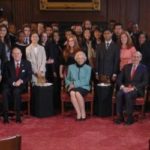When the stories of We the People become cases before the U.S. Supreme Court, and when those cases result in the opinions of the Court, history turns. The ways we think about and live under the Constitution are reflected in the Court’s interpretations in both their historical contexts and their legacies. Some cases — and the Court’s opinions in them — so profoundly alter our constitutional understandings that they can only rightly be called Landmark Cases, markers of where we have traveled as a nation. In this way, the Landmark Cases show us what we have tried, where we have been, and where we are — leaving We the People and future sessions of the Supreme Court to determine how we move forward toward a more perfect union.
Landmark Supreme Court Cases
In a partnership with the National Constitution Center, Khan Academy talked to constitutional scholars about ten of the most significant Supreme Court cases in history. Teachers can use this lesson as a supplemental resource during their Supreme Court unit to show how constitutional scholars can debate the outcomes of Supreme Court cases, as well as the impact these cases have had on the United States.
Supreme Court Cases On Display
The purpose of this lesson is to have students working in groups of two or three focus of one historic Supreme Court case. Students will understand the process of bringing a case to the Supreme Court, read arguments and discover the importance of this third branch of government. Students will discover the changes these cases made in the lives of people. Then students can determine how the outcome may have affected their lives.
Use Constituting America’s Constitution Archives on U.S. Supreme Court Cases and Justices to support this lesson.
A Conversation on the Importance of the Japanese Internment Cases

Justices Stephen G. Breyer, Sandra Day O’Connor and Anthony M. Kennedy discuss two landmark cases, Korematsu v. U.S. and Hirabayashi v. U.S., in which the Supreme Court tried to strike a balance between individual rights and national security during wartime. The cases stem from President Franklin Roosevelt’s 1942 executive order that mandated the relocation of Japanese and Japanese Americans to internment camps. This video complements the documentary Korematsu and Civil Liberties.
Participate in the Judicial Process – Rule of Law
Review the facts, rulings, majority and minority opinions, and reasoning of these two landmark Fourteenth Amendment Supreme Court cases – Batson v. Kentucky and J.E.B. v. Alabama.
Sixth Amendment Activities
Apply landmark Supreme Court cases to contemporary scenarios related to your right to counsel and your right to a fair trial in the Sixth Amendment.
Right to Counsel
In this lesson, students will look at the various dimensions of right to counsel. They will study how the meaning of this right has evolved over time with reference to specific landmark United States Supreme Court cases. Students will develop lists of reasons why such a right is important to the functioning of the adversary process. The lesson ends with an examination of the role of the criminal attorney.
Landmark Supreme Court Cases – Freedom of the Press
From the first days of American history until today, the Supreme Court has been pivotal in interpreting the Constitution and shaping America’s constitutional republic. Read summaries of the majority ruling in landmark Supreme Court cases that have had an impact on our rights as citizens.
Landmark Supreme Court Cases – Incorporation
From the first days of American history until today, the Supreme Court has been pivotal in interpreting the Constitution and shaping America’s constitutional republic. Read summaries of the majority ruling in landmark Supreme Court cases that have had an impact on our rights as citizens.
Landmark Supreme Court Cases – Personal Liberty
From the first days of American history until today, the Supreme Court has been pivotal in interpreting the Constitution and shaping America’s constitutional republic. Read summaries of the majority ruling in landmark Supreme Court cases that have had an impact on our rights as citizens.